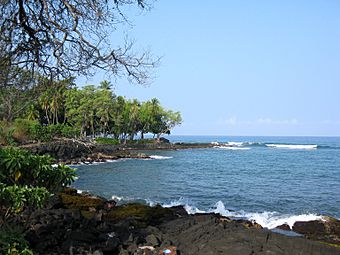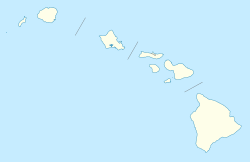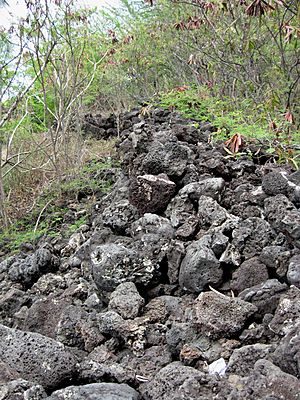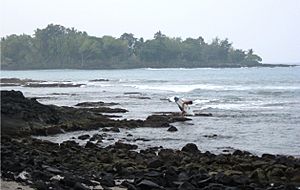Holualoa Bay facts for kids
Quick facts for kids |
|
|
Holualoa 4 Archeological District
Kamoa Point Complex |
|

Kamoa Point on Hōlualoa Bay
|
|
| Location | Aliʻi Drive, Kailua-Kona, Hawaii |
|---|---|
| Area | 28.4 acres (115,000 m2) |
| Built | 1300 - 1800 |
| Architectural style | Ancient Hawaii |
| NRHP reference No. | 83000247 05000542 |
| Added to NRHP | June 8, 2005 |
Hōlualoa Bay is a special historic place on the Big Island of Hawaiʻi. It sits between the towns of Kailua-Kona and Keauhou Bay. The name "Hōlualoa" means "long slide" in the Hawaiian language. This name comes from an old trail. People used this trail to slide logs down from the Hualālai mountain. These logs were then made into canoes near the bay. Over many centuries, a large royal complex was built right here.
Contents
Ancient Hawaiian History
Royal Life at Hōlualoa
Long ago, in the 1600s, a powerful queen named Keākealaniwahine built a large group of buildings here. She was one of the first known queens to rule the entire island of Hawaiʻi. People had lived in this area for hundreds of years before her.
The royal complex had many parts. It included homes for the royal family and important people. There were also special ancient temples called Heiaus. One temple, Hikapaia, was for making sure there was plenty of food and fish. Another, Hualani, was a place to learn about healing plants and medicines. The area also had places where important people were buried.
Queen Keakealaniwahine's mother, Keakamahana, was the first royal person known to live here. The land uphill from Aliʻi Drive was recognized as a historic place in 2005. It's called the Holualoa 4 Archeological District.
Kamoa Point Complex
On the other side of Aliʻi Drive, closer to the ocean, is the Kamoa Point Complex. This area was also very important. It had a temple especially for surfers, called the Haleʻaʻama Heiau. There was also a large sports area named after a chiefess called Keolonāhihi, who lived around the year 1300. This was a place where warriors could practice their skills.
Some stories say that Keolonāhihi was the daughter of Pa'ao. He was a famous priest who may have brought the Hawaiian religion to Hawaiʻi from a faraway land. Over time, the Kamoa Point Complex grew. It even had a special terraced grandstand where people could sit and watch surfing contests. This complex was added to the National Register of Historic Places in 1983.
Kamehameha I and Sports
Kamehameha I, who was the great-great-grandson of Queen Keakealaniwahine, likely learned to surf here when he was young. Later, when he became king, he lived further north. But he still kept a temple here called Hale O Kaili. This temple was dedicated to Kū, the Hawaiian god of war.
Even though Hōlualoa was used for building canoes, sliding down the lava rock became a popular sport for the upper class. This sport was called heʻe hōlua. Kamehameha even built a huge ramp just for this sport a few miles south. Parts of this ramp, known as the Keauhou Holua Slide, are still preserved today.
Changes Over Time
Decline of Old Ways
After Kamehameha I passed away in 1819, the Hawaiian royalty decided to adopt Christianity. They took apart many of the old temples. In 1823, a visitor named William Ellis explored the area. He wrote about the ruins, noting that the "idols" (statues of gods) had been removed. However, the structures themselves were still in good condition. He described one large walled area. The place was called Kaluaokalani at that time, but this name was later forgotten. Over the years, different names for the site have caused some confusion.
Modern Developments
In 1848, the land became privately owned. Later in the 1800s, the small beach trail was made into a bigger road, which cut through the ancient complex. In the early 1900s, some farming and cattle grazing damaged parts of the site. A few private homes were also built.
In 1956, a company bought some land to build a hotel. But only a few small vacation homes were built because local people were against the idea. There have been plans for new roads through the area, but these projects have been put on hold for many years. In 2010, there was a proposal to build a four-story apartment complex, which also met with local opposition.
On the north side of the bay, a small Christian church called Hale Halawai O Holualoa was built in the 1800s. It was repaired in the 1990s and is now known as the "Living Stones Church".
Recreation and Preservation
Surfing Spots
The north side of Hōlualoa Bay has a lava ridge that creates a famous surf break called "Banyans". Even though there are no banyan trees left, the name stuck. There are small areas of sandy beach, but the strong waves and currents can be dangerous. Only experienced surfers should try to surf here. Banyans often hosts a surf contest, usually in February.
On the south side of the bay, along Kamoa Point, there's another popular surf break called "Lyman's". It's named after a former resident, Howard Lyman. This spot is a favorite among all surfers. A song called "Laimana" was even written about it in 1956.
Keolonāhihi State Historical Park
The State of Hawaii bought some land at Kamoa Point in 1990. The goal was to create the Keolonāhihi State Historical Park. Some work has been done to clear the area, but as of 2009, it mostly has a narrow public walking path. More land was added to the park in 1998 and 2005, helping to protect this important historical area.
Images for kids






